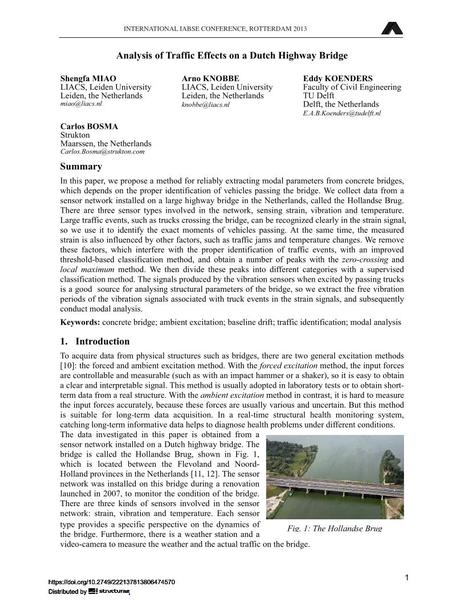Analysis of Traffic Effects on a Dutch Highway Bridge

|
|
|||||||||||
Détails bibliographiques
| Auteur(s): |
Shengfa Miao
Arno Knobbe Eddy Koenders Carlos Bosma |
||||
|---|---|---|---|---|---|
| Médium: | papier de conférence | ||||
| Langue(s): | anglais | ||||
| Conférence: | IABSE Conference: Assessment, Upgrading and Refurbishment of Infrastructures, Rotterdam, The Netherlands, 6-8 May 2013 | ||||
| Publié dans: | IABSE Conference, Rotterdam, May 2013 | ||||
|
|||||
| Page(s): | 148-149 | ||||
| Nombre total de pages (du PDF): | 8 | ||||
| Année: | 2013 | ||||
| DOI: | 10.2749/222137813806474570 | ||||
| Abstrait: |
In this paper, we propose a method for reliably extracting modal parameters from concrete bridges, which depends on the proper identification of vehicles passing the bridge. We collect data from a sensor network installed on a large highway bridge in the Netherlands, called the Hollandse Brug. There are three sensor types involved in the network, sensing strain, vibration and temperature. Large traffic events, such as trucks crossing the bridge, can be recognized clearly in the strain signal, so we use it to identify the exact moments of vehicles passing. At the same time, the measured strain is also influenced by other factors, such as traffic jams and temperature changes. We remove these factors, which interfere with the proper identification of traffic events, with an improved threshold-based classification method, and obtain a number of peaks with the zero-crossing and local maximum method. We then divide these peaks into different categories with a supervised classification method. The signals produced by the vibration sensors when excited by passing trucks is a good source for analysing structural parameters of the bridge, so we extract the free vibration periods of the vibration signals associated with truck events in the strain signals, and subsequently conduct modal analysis. |
||||
